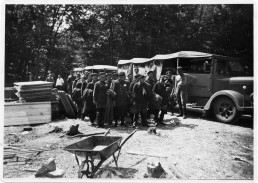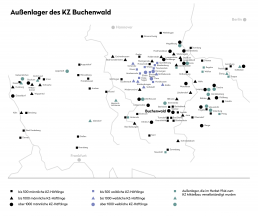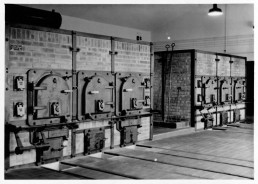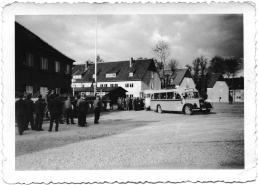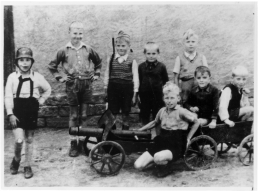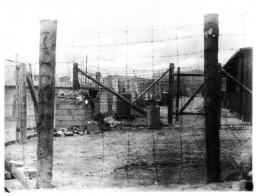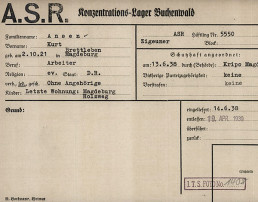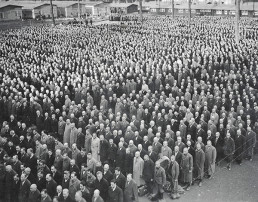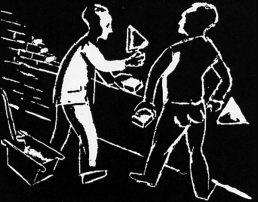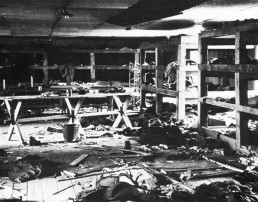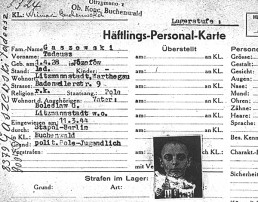The Camp
In July 1937, the first prisoners arrived at Ettersberg near Weimar. The SS forced them to build a concentration camp for 8,000 male prisoners. Both political opponents of the regime and those persecuted for racial and social reasons were to be interned there.
By the end of the war, the Buchenwald Concentration Camp had developed into the center of a complex camp system with a total of 139 subcamps, where prisoners served as forced laborers for the armaments industry. In total, around 280,000 people were imprisoned at Buchenwald, and more than 56,000 died.
Not only men, but also women, teenagers and children were imprisoned in Buchenwald and its satellite camps. Children were in particular danger. Because they were unable to work, they had hardly any chance of survival. To protect them from forced labor and deportation to certain death, political prisoners built shelters for children and adolescents in selected barracks.
Beyond the main camp: A dense network of subcamps.
Most of the Buchenwald Concentration Camp’s subcamps camps were established after 1942, the turning point of the war after the Battle of Stalingrad. Prisoners were used for cleanup work in the cities and for forced labor in the armaments industry.
(Studio IT’S ABOUT)
Interior of the crematorium at the Buchenwald Concentration Camp, 1943.
Before 1940, the deaths of prisoners from the Buchenwald Concentration Camp were registered and their bodies cremated at the municipal crematorium in Weimar. In order to conceal the increasing number of prisoners murdered at the camp, a separate crematorium was built on camp premises in the summer of 1940. The incinerators were made by the Erfurt company Topf & Sons, which also manufactured the incinerators for the Auschwitz Concentration Camp.
The photo is from an album that camp commandant Hermann Pister had created for representational purposes.
(Musée de la Résistance et de la Deportation)
Children of SS members pose in front of a toy cannon in the Führersiedlung at the Buchenwald Concentration Camp, 1943.
The SS barracks and housing estates were located only a few meters from the camp on the Ettersberg. SS officers and their families lived in the Führersiedlung.
(Photo: Georges Angéli, Buchenwald Memorial)
Camp road and barracks in the Little Camp, after liberation, April/May 1945.
In the Little Camp, which was established in 1942 as a quarantine zone for prisoners arriving on the mass transports, conditions were catastrophic. From 1944 onwards it was permanently overcrowded; starvation and death were ever-present. Political prisoners managed to establish a place of refuge for children, most of them Jewish, in Block 66 of the Little Camp.
(Photo: Alfred Stüber, private property)
Jurek Kestenberg on his memories of Buchenwald in an interview with David P. Boder, Fontenay-aux-Roses (France), 31 July 1946.
Jurek Kestenberg was born in Poland in 1929. He and his parents were deported from the Warsaw Ghetto to Majdanek in 1943. In August 1944 he was sent to Buchenwald. He survived thanks to the help of fellow prisoners. After liberation, he traveled to France on a children’s transport in June 1945, where Boder interviewed him in Yiddish.
(„Voices of the Holocaust“, Illinois Institute of Technology)
FURTHER INFORMATION:
Buchenwald and Mittelbau-Dora Memorials Foundation, Historical Overview of the History of the Buchenwald Concentration Camp, 1937-1945: buchenwald.de/en
Förderverein Buchenwald e.V.: „Buchenwald war überall – die Errichtung eines Netzwerkes der Außenlager“:
aussenlager.buchenwald.de.
“Gedenksteine Buchenwaldbahn. Ein Projekt der Initiative “Gedenkweg Buchenwaldbahn”:
gedenksteine-buchenwaldbahn.de.
Children in the Buchenwald Concentration Camp
Aktion Arbeitsscheu Reich 1938
In 1938, the number of prisoners in the concentration camps doubled. As part of the Aktion Arbeitsscheu Reich (Operation Work-Shy Reich, two waves of arrests of purported “anti-social…
1938: Deported to Buchenwald as “special operation Jews”
In the course of the November pogroms of 1938, the Gestapo sent 30,000 Jews, designated by the SS as “special operation Jews,” to concentration camps.
Rescue Initiatives: Bricklayers’ school and Poles’ school
Under the pretext of training skilled workers for the German war effort, prisoner functionaries around Robert Siewert, a political prisoner and Kapo of the construction detail
Limited shelter: The children’s blocks 8 and 66
Children were particularly vulnerable to the dangers of the camp. To protect them, political prisoner functionaries set up a children's block in Block 8 of the main camp in July 1943.
Deterrence through forced labor: Disciplinary work prisoners
From 1941 to 1944, a Gestapo labor re-education camp existed at the Buchenwald Concentration Camp.
